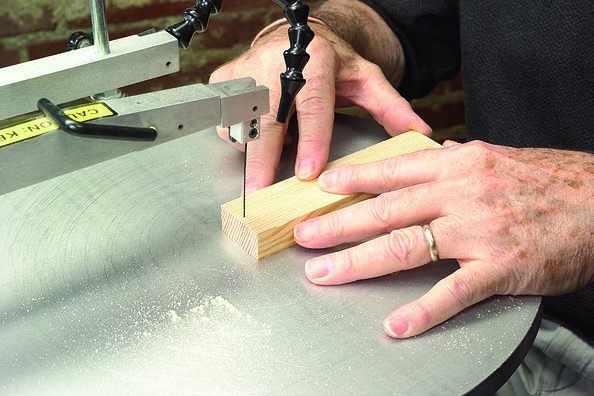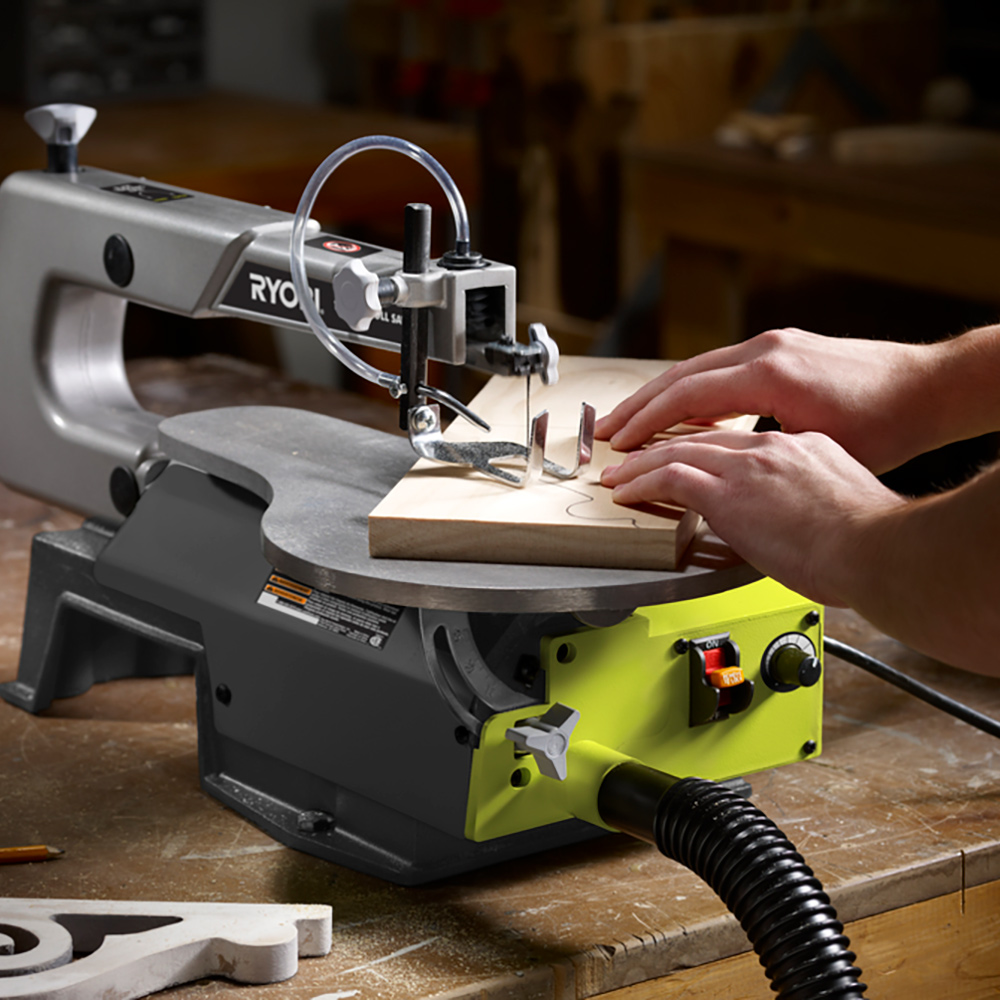Have you ever wondered how thick a scroll saw can cut? Well, you’re in for a treat! In this article, we’ll explore the capabilities of scroll saws and the maximum thickness they can handle. So, if you’re interested in woodworking or just curious about different tools, keep reading!
A scroll saw is a versatile and handy tool used in woodworking to create intricate cuts and designs. Whether you’re working on a craft project or making furniture, a scroll saw can be a game-changer. But how thick can it really cut? That’s the burning question we’ll answer here.
When it comes to the thickness a scroll saw can handle, there are a few factors to consider. Blade type, motor power, and the material being cut all play a role. So, let’s dig in and discover the maximum thickness a scroll saw can handle. Get ready to unleash your creativity and find out the secrets of scroll sawing!

How Thick Can a Scroll Saw Cut? Understanding the Capabilities of this Versatile Tool
Scroll saws are powerful tools that offer intricate cutting capabilities for a variety of materials. Whether you are a professional woodworker or a DIY enthusiast, understanding how thick a scroll saw can cut is essential for determining the suitability of the tool for your projects. In this article, we will explore the factors that determine the maximum cutting thickness of a scroll saw, the typical range of thicknesses it can handle, and some tips to optimize its performance.
The Factors Influencing the Cutting Thickness of a Scroll Saw
Before discussing the specific thicknesses that a scroll saw can handle, it is important to understand the factors that play a role in determining its cutting capacity:
Type of Scroll Saw Blade
The type and size of the scroll saw blade have a significant impact on the cutting thickness. Scroll saw blades come in various types, including standard, skip tooth, double tooth, and reverse tooth blades. Each blade has its own cutting capacity, measured in terms of the maximum thickness of the material it can cut through effectively.
Scroll Saw Motor Power
The power of the scroll saw motor also affects its cutting capacity. Higher-powered scroll saws can generate more force, allowing them to cut through thicker materials with ease. It is important to choose a scroll saw with adequate motor power for the thicknesses you typically work with.
Material Hardness
The hardness of the material being cut can impact the cutting thickness. Softer materials, such as wood or plastic, are generally easier to cut through than harder materials like metal or glass. When working with hard materials, it is essential to use the appropriate blades and apply the correct cutting technique.
Scroll Saw Tension and Speed
The tension of the scroll saw blade and the speed at which it is operated also influence the cutting thickness. Proper tensioning ensures the blade stays in place during cutting, and adjusting the speed allows for better control and precision. Finding the right combination of tension and speed is crucial for optimal cutting results.
The Typical Cutting Thickness Range for Scroll Saws
Scroll saws have a wide range of cutting capacities, with the ability to handle various materials and thicknesses. While the exact range may vary depending on the specific model and blade used, scroll saws typically offer cutting capacities in the following range:
Wood:
Scroll saws are commonly used for woodworking projects, and they excel at cutting through various types of wood. With the right blade and proper technique, a scroll saw can cut through wood thicknesses ranging from 1/8 inch to 2 inches or more. However, it’s important to note that thicker wood may require slower cutting speeds and different blade configurations.
Plastic and Acrylic:
Plastic and acrylic materials are also well-suited for scroll saw cutting. Depending on the specific blade and the hardness of the material, scroll saws can effectively cut through plastic and acrylic thicknesses ranging from 1/8 inch to 1 inch.
Metal:
Scroll saws can also be used to cut through thin metal sheets, such as aluminum or brass. However, the cutting capacity for metals is generally limited to thicknesses up to 1/8 inch. It is important to use specialized blades designed for metal cutting and to apply appropriate cutting techniques to avoid heat buildup and blade damage.
Glass and Ceramic:
While not the primary application for scroll saws, they can be used for intricate cutting in delicate materials such as glass and ceramic. However, the cutting thickness for these materials is limited to very thin sheets, typically less than 1/8 inch. Specialized blades and careful handling are required to prevent breakage and ensure clean cuts.
Tips for Maximizing the Cutting Thickness of Your Scroll Saw
To get the most out of your scroll saw and achieve the maximum cutting thickness, consider the following tips:
Choose the Right Blade for the Material
Using a blade specifically designed for the material you are cutting is crucial for achieving optimal results. Different blade types have varying tooth configurations and cutting capacities, so make sure to choose the appropriate blade for the thickness and hardness of your material.
Properly Tension the Blade
Ensuring the scroll saw blade is properly tensioned is essential for maintaining cutting accuracy and preventing blade breakage. Refer to the manufacturer’s guidelines for the recommended blade tension settings and make any necessary adjustments before starting your project.
Use the Correct Cutting Speed
Adjusting the cutting speed of your scroll saw can greatly impact the cutting performance. Slower speeds are generally recommended for thicker materials, allowing for better control and minimizing the risk of blade overheating or breakage. Experiment with different speeds to find the optimal setting for the thickness you are working with.
Practice Proper Cutting Techniques
Mastering the proper cutting techniques for different materials can significantly enhance your scroll saw’s cutting capacity. Experiment with feed rate, cutting direction, and blade angles to achieve clean and precise cuts. Remember to let the saw do the work and avoid forcing the material through the blade.
In Summary
Scroll saws have varying cutting capacities depending on factors such as blade type, motor power, material hardness, and tension. While the specific cutting thickness range may vary, scroll saws are generally capable of cutting through wood up to 2 inches thick, plastic and acrylic up to 1 inch thick, and metals and delicate materials up to 1/8 inch thick. By choosing the right blade, adjusting tension and speed, and employing proper cutting techniques, you can maximize the cutting thickness of your scroll saw and achieve precise and clean cuts for your projects.
Key Takeaways: How Thick Can a Scroll Saw Cut?
- A scroll saw can typically cut materials up to 2 inches thick, depending on the type and power of the saw.
- Thicker materials may require multiple passes or the use of specialized blades.
- It’s important to select the right blade for the thickness and type of material you are working with.
- Scroll saws are ideal for intricate and detailed cuts in thin materials like wood and acrylic.
- Always prioritize safety when using a scroll saw, wearing appropriate protective gear and following manufacturer guidelines.
Frequently Asked Questions
Scroll saws are versatile tools that can cut through various materials with precision. If you’re wondering about the maximum thickness a scroll saw can handle, check out these commonly asked questions:
How thick of a material can a scroll saw cut through?
A scroll saw is designed to cut through materials that range in thickness from thin veneer to around 2 inches. However, the maximum thickness it can handle may depend on factors such as the saw’s horsepower, the quality of the blade, and the type of material being cut. If you’re working with a thicker material, it’s best to consult the manufacturer’s specifications to ensure you’re within the recommended limits for your particular scroll saw model.
Keep in mind that when cutting thicker materials, you may need to make multiple passes to achieve a clean cut. This is because scroll saw blades have a limited cutting depth, and forcing the blade through thicker materials in one go can result in a rough or uneven cut. Taking your time and making incremental cuts will help you achieve better results and prolong the life of your blades.
Are there any materials that a scroll saw cannot cut through?
While scroll saws can cut through a wide range of materials, there are some that may not be suitable for this tool. Materials such as metal or thick hardwoods with high density and hardness may exceed the capabilities of a scroll saw. These materials require specialized tools like band saws or rotary tools with appropriate cutting attachments.
It’s also important to note that scroll saws are typically designed for making intricate cuts and detailed patterns, rather than rough cuts or heavy-duty cutting tasks. For such applications, alternative tools like jigsaws or circular saws may be more appropriate.
Can a scroll saw cut straight lines?
Yes, a scroll saw can cut straight lines with ease. Although it is often associated with intricate curves and shapes, the scroll saw can be used to make straight cuts as well. To achieve a straight line, you can use a straight-edge guide or clamp a piece of wood alongside the cut line to act as a guide for the saw blade.
Additionally, the speed and control provided by scroll saws allow for precise straight cuts, making them a versatile tool for various woodworking projects that require both intricate and straight cuts.
Can I cut thick plywood with a scroll saw?
Yes, it is possible to cut thick plywood with a scroll saw. However, cutting thicker plywood can present a few challenges. Firstly, make sure you are using a blade suitable for cutting plywood. It’s recommended to use a blade with medium-sized teeth that can handle the thicker material more efficiently.
Secondly, adjust the speed of your scroll saw to a lower setting to prevent the blade from overheating and reduce vibration, ensuring a smoother cutting experience. Additionally, take your time and make multiple passes if necessary, especially when cutting through thicker plywood, to avoid straining the blade and achieve cleaner cuts.
What other factors should I consider when cutting thicker material with a scroll saw?
When cutting thicker materials with a scroll saw, there are a few additional factors to consider. Firstly, ensure you have a sturdy work surface and secure the material firmly in place to prevent it from moving during the cutting process. This will help maintain accuracy and safety.
Additionally, consider the type of blade you’re using. Different blade types are designed for specific materials and cutting purposes. For thicker materials, using skip tooth blades or blades with deeper gullets can help remove sawdust more efficiently and prevent blade clogging. Lastly, always prioritize safety by wearing appropriate eye and ear protection, as well as following the manufacturer’s guidelines for your scroll saw model.

DeWalt Scroll Saw Review And Scroll Saw Tips! / How Thick Can It Cut?
Summary
So, how thick can a scroll saw cut? The thickness depends on the type of scroll saw and the blade being used. Typically, most scroll saws can cut wood up to 2 inches thick, while some heavy-duty models can cut even thicker materials like metal or thick acrylic.
If you’re using a scroll saw for your projects, make sure to use the appropriate blade for the material and thickness you’re working with. Always follow safety guidelines and wear protective gear, like safety glasses, when operating a scroll saw. With the right tools, you can create amazing and intricate designs with your scroll saw!
